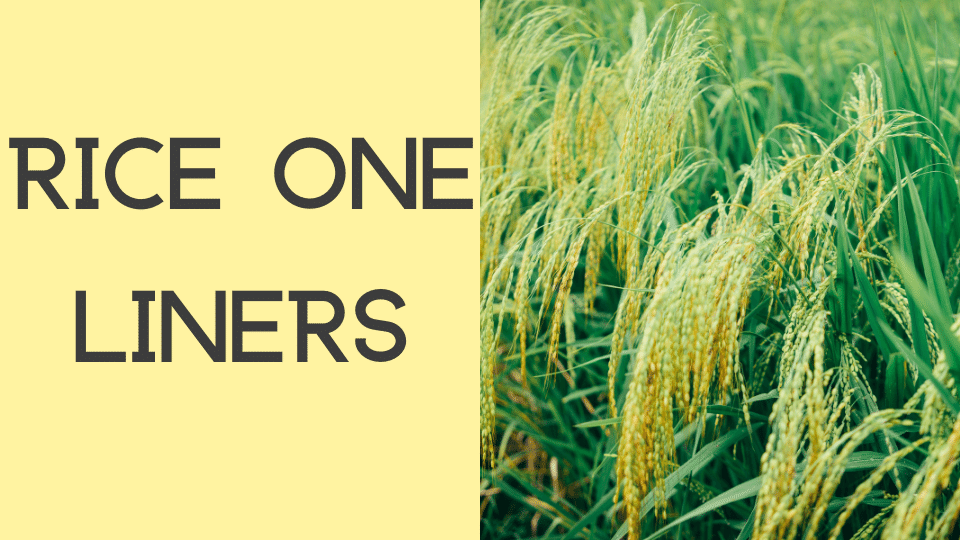- August 1, 2021
- Team CrackAgri
- 0

Rice One Liners
Q. Scientific name of rice.
Ans. Oryza sativa 2n = 24
Q. Family of rice.
Ans. Graminae
Q. Origin of rice.
Ans. South East Asia
Q. Sowing time of Aus/Autumn rice
Ans. March-April
Q. Sowing time of Aman rice.
Ans. May-June
Q. Sowing time of Boro rice.
Ans. December-January
Q. Aman rice also known as.
Ans. Kharif/winter rice
Q. Optimum temperature for cultivation
Ans. 30-35°C
Q. Boro rice also known as.
Ans. Summer rice
Q. Lodging doesn’t occur in.
Ans. Japonica rice
Q. Rice inflorescence is known as.
Ans. Panicle
Q. Stem of rice is called
Ans. Hull
Q. Hull is combination of.
Ans. Lemma + Palea together
Q. SRI stands for
Ans. System of Rice Intensification.
Q. SRI concept
Ans. Increasing productivity by changing management of plants, soil, water and nutrients.
Q. SRI was first synthesized by
Ans. Fr. Henri de Laulanie under drought conditions at Madagascar in 1983.
Q. Yield increased by adopting SRI is
Ans. 50 to 90%
Q. Highest rice producing state in India.
Ans. West Bengal
Q. Test weight of basmati rice grain is.
Ans. 21 gm.
Q. Rice is a type of plant.
Ans. Self pollinated & Short day plant
Q. Cardinal temperature of rice is.
Ans. 30-32°C bio.001
Q. Hulling % of rice is.
Ans. 70-75%
Q. First developed rice variety.
Ans. T.N.-1
Q. Jagannath is the mutant variety of.
Ans. T.N.-141
Q. The World’s first high yielding variety (dwarf) of rice that has been developed by IARI.
Ans. Pusa Basmati-1
Q. Hybrid rice which is released by private organization.
Ans. PHB-71
Q. Most critical stage for water.
Ans. Booting stage
Q. Seedling ready for transplanting in Depog method.
Ans. 12th day
Q. Best Biofertilizer for rice.
Ans. Azolla
Q. Area required for rice nursery.
Ans. 700-800 m2 (.05 ha)
Q. Fruit of rice is known as.
Ans. Caryopsis
Q. Widely used nitrogenous fertilizer in rice.
Ans. Ammonium Sulphate
Q. Most dominant weed sp. in rice.
Ans. Echinochloa sp.
Q. White eye of rice is due to.
Ans. Fe deficiency
Q. Killer diseases of rice are:
Ans. Tunger virus
Q. The gas emitted from rice field is.
Ans. Methane
Q. Akiochi disease is due to.
Ans. HS
Q. Highest N losses in rice field is by.
Ans. Denitrification
Q. Paira & utera cropping system is closely related to
Ans. Rice
Q. Puddler & puddling is related to.
Ans. Rice
Q.Hydrothermal treatment of rice grain before milling
Ans. Paraboiling
Q. Moisture requirement for rice growing
Ans. 1200 mm
Q. Parboiling of rice conserve the vitamin.
Ans. Vitamin-B2
Q. Seed rate in depog method for rice.
Ans. 3-4 kg/m2
Q. Area required for seedling preparation in Depog
Ans. 25-30 m
Q. Miracle rice (first dwarf variety) of India is.
Ans. Jaya
Q. Gene responsible for dwarfness in rice.
Ans. Dee-Gee-Woo-gene
Q. Space for sowing of seedlings of rice.
Ans. 20 x 10 cm
Q. Khaira diseases of rice is due to
Ans. Zinc deficiency (AAO 2009)
Q. Optimum pH of soil required for growing rice is
Ans. 4-6
Q. Seed rate of hybrid rice is
Ans. 6-10 kg acre
Q. First Super aromatic Basmati rice is
Ans. Pusa RH – 10
Q. Saline tolerant rice variety is
Ans. SR 26 B
Q. Vikramarya rice variety is resistant for
Ans. Tungro virus
Q. Ajaya rice variety is resistant for
Ans. Bacterial Blight
Q. Phalguna rice variety is resistant for
Ans. Gall midge
Q. State known as “Bowl of Rice” is
Ans. Chhattisgarh
Q. Vitamin rich in golden yellow rice is
Ans. Vitamin A
Q. Total districts of India in paddy growing
Ans. 564 districts
Q. The Bio herbicide used in rice cultivation is
Ans. Collego
Q. Bronzing disease of rice is associated with high concentration of
Ans. Ferrous
Q. Value of Albedo for rice crop is about M
Ans. 12%
Q. Harvest Index of Rice
Ans. 0-40
Q. What percentage of world’s dietary energy source is provided by rice?
Ans. 20 percent
Q. From where does black rice obtain its color?
Ans. It obtains it from anthocyanins and tocols which contain antioxidants useful for human health.
Q. Where are anthocyanins and gamma tocols located in black rice?
Ans. They are located in the inner portion of black rice
Q. What do red and black rice provide?
Ans. The consumption of red and black rice reduces or retards the progression atherosclerotic plaque development, induced by ‘dietary cholesterol, in
mammals.
Q. What does white rice provide?
Ans. It is a good source of magnesium, phosphorus, manganese, selenium, iron, folic acid, thiamine and niacin
Q. Golden rice is genetically modified crop plant where the incorporated genes are meant for the biosynthesis of?
Ans. Beta Carotene
Q. Which country produces the largest quantity of rice in the world?
Ans. China
Q. What are the different varieties of rice?
Ans. Brown rice, black/purple rice, red rice, wehani rice and white rice.
Q. Green revolution in India has so far been the most successful in the case of?
Ans. Rice and Wheat
Q. Inter-racial hybridization programme between japonicas and indicas varieties of which among the following crops was initiated during 1950-54?
Ans. Rice
Q. Why using cooked rice for the next day can be toxic?
Ans. Cooked rice contains Bacillus Cereus spores which produce toxicity at a temperature of 4-60 degree Celsius.
Q. The de hulled rice grain is known as
Ans. Brown Rice
Q. Climate suitable for Rice crop is
Ans. Hot & humid
Q. Optimum temperature range for ripening of rice is
Ans. 20-25°C
Q. The BGA bio fertilizer is most useful for the crop
Ans. Rice
Q. IR-8 variety of rice is introduced in India from the country
Ans. Philippines (1966)
Q. In wet bed method of nursery the seedling would be ready for transplanting in stage of
Ans. 20-25 Days
Q. Idea super Rice was given by
Ans. G. S. Khush NH, fertilizer in
Q. Nitrogen losses in rice can be reduced by placing
Ans. Reduced Zone
Q. Among the cereal crop which consumed highest water for the production of 1 kg dry matter
Ans. Rice
Q. Main protein of Rice is
Ans. Oryzenin
Q. Rice grain is relatively rich in
Ans. lysine
Q. Most widely used post emergence herbicide in Rice is
Ans. Propanil (C,H,CI,NO)
Q. Highest area of rice in world
Ans. India
Q. New Paddy variety useful for salt affected areas
Ans. CSR-43 (Released by U.P.)
Q. Rice variety suitable for direct seeding is
Ans. Bala
Q. BLB tolerant variety is
Ans. TKM-6
Q. Variety suitable for water logged condition is
Ans. Jalmagna
Q. First hybrid of basmati in world
Ans. PRH-10
Q. First hybrid rice in India
Ans. CORH-1 (1994)
Q. Rice seed rate for Drilling
Ans. 60 kg/ha
Q. Rice seed rate for broadcasting
Ans. 100kg/ha
Q. Optimum population of rice hill per m² is
Ans. 50 hills per m²
Q. Nitrogen use efficiency of rice is
Ans. 30-40%
Q. Micro nutrient which is more essential for rice
Ans. Silicon
Q. Effect of pudling on soil bulk density
Ans. It increase the bulk density
Q. Two critical stage of water in rice
Ans. Booting and Tellering stage
Q. Country which developed first hybrid rice
Ans. China (By. Sh. Yuan Longping (known as father of hybrid rice) This variety can produce 13.9 tons of rice per hectare).
Q. During milling process rice loose the vitamin
Ans. Vitamin B
Q. Spacing of rice sowing of seedling is
Ans. 20 x 10 cm
Q. Length of extra long rice is
Ans. 7 mm or more
Q. Long grain rice are higher in amylose and medium and short grain rice are high in
Ans. amylopectin (starch molecule)
Q. What is plastic rice?
Ans. Plastic rice is made mixing potato, sweet potatoes and resin (plastic) together, shaping into grain
Q. Hybrid Rice given by
Ans. Yuan Longping (Known as father of Hybrid Rice). This variety produces 13.9 tonnes per hectare.
Q. Golden rice was developed by
Ans. Ingo Potrykus and Peter Bayer (Year 2000)
